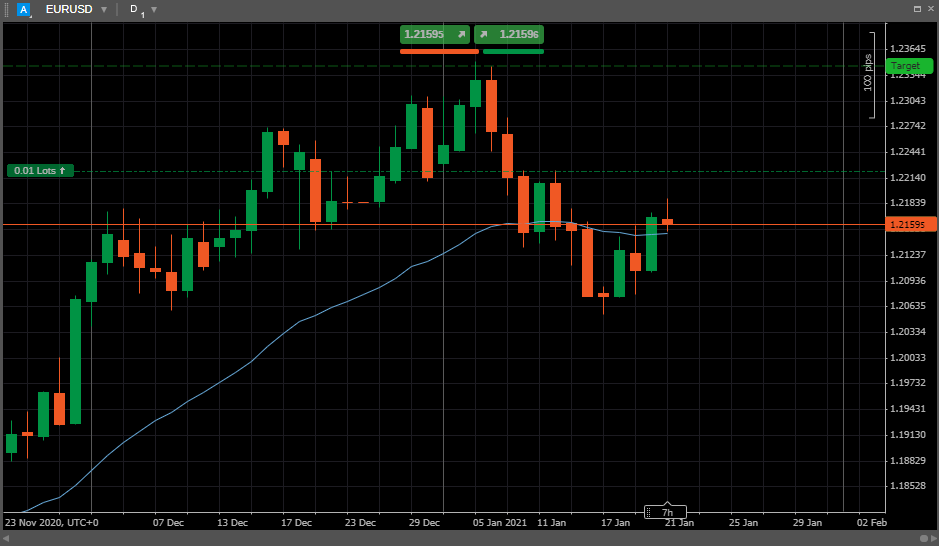The EMA (Exponential Moving Average) is a type of Moving Average indicators that concentrates a greater weight on the most recent time data and reacts more significantly to recent price changes than a simple moving average (SMA), which applies an equal weight to all observations in the period.
Because of its unique calculation, the EMA follows the prices more closely than a corresponding SMA. The EMA is also known among traders as the Exponentially Weighted Moving Average.

Calculation #
When calculating the EMA indicator, one should notice that it uses the previous time value in its calculation. This means the EMA includes all the price data within its current value.
The newest price data has the most impact on the Moving Average and the oldest prices data has only a minimal impact. The EMA is calculated with the following formula:
EMA = (K x (C - P)) + P
Where:
C = current price
P = previous periods EMA (the SMA is used for the first period calculations)
K = exponential smoothing constant
The exponential smoothing constant K applies appropriate weight to the most recent price. It uses the number of periods specified in the moving average. While there are many possible choices for the smoothing factor, the most common choice is 2.
Usage #
In general, traders find the Moving Averages quite useful when applied correctly. But at the same time, one should realize that those signals may become devastating when misused or misinterpreted.
Consequently, the conclusions from applying a Moving Average to a particular market chart should be a confirmation of a price move or its strength. The optimal time to enter the market often passes before a moving average shows that the trend has changed.
When using the EMA indicator, one can apply the same rules that are applied to the SMA but keeping in mind that the EMA is more sensitive to the price movement. On the one hand, it helps in identifying trends earlier than an SMA.
On the other hand, the EMA will most probably experience more short-term changes than a respective SMA.
The EMA can be used for determining the trend directions and trading within those directions. When the EMA rises, one should consider buying when prices dip near or slightly below the EMA.
When the EMA falls, one should consider selling when the prices rally towards or just above the EMA.
Also, the Moving Averages can be used for indicating the support and resistance areas. For example, a rising EMA tends to support the price action, while a falling EMA tends to provide resistance to price action.
This reinforces the strategy of buying when the price is near the rising EMA and selling when the price is near the falling EMA.
Limitations #
All types of Moving Averages, including the EMA, are not designed to identify a trade at the exact bottom and top. Moving averages may help you trading in the general direction of a trend, but with a delay at the entry and exit points.
The EMA has a shorter delay than the SMA with the same period.
Also, It is unclear whether or not more attention should be paid to the most recent days in the time period. Many traders believe that the new data better reflects the current trend of a symbol, while others feel that overweighting recent dates may lead to false alarms.
In Ananda, you can find the Exponential Moving Average indicator among the other built-in indicators. See the Indicators section to learn how to use them.































